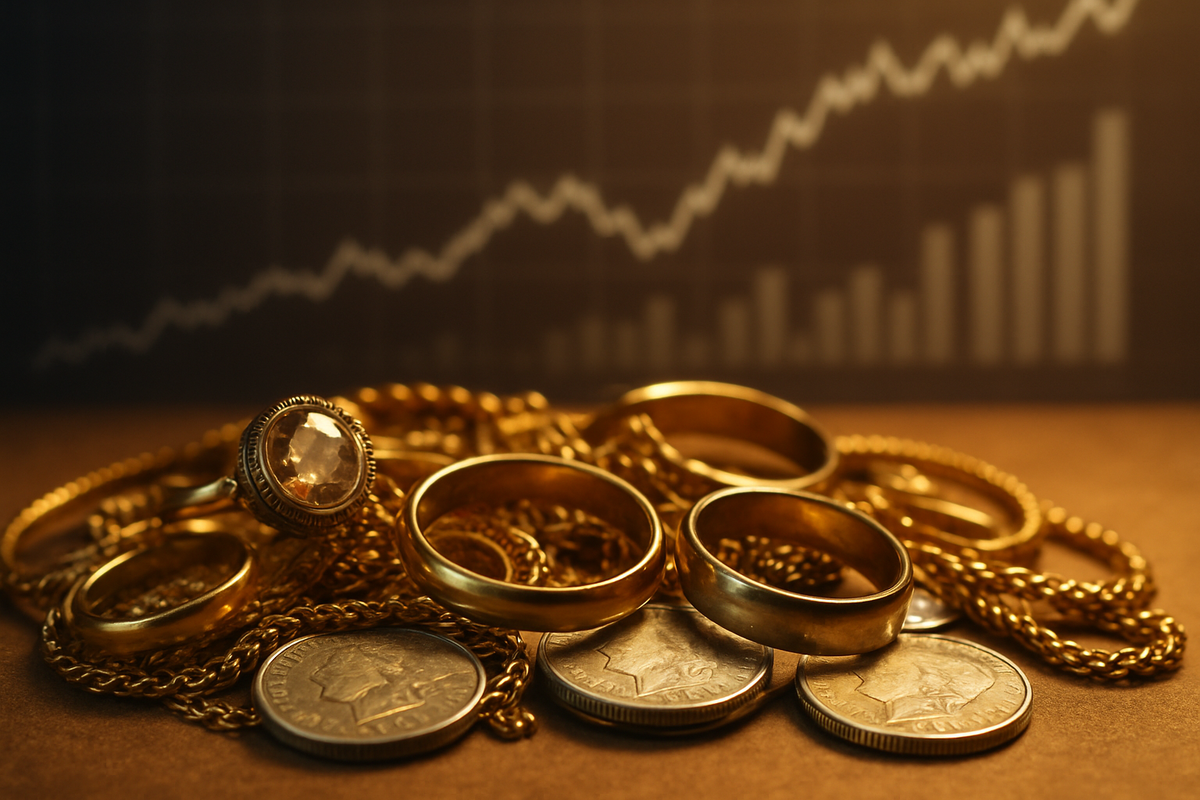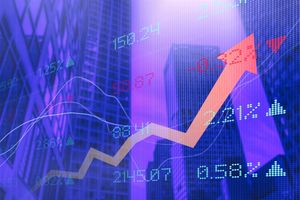
October 16, 2025 – A gleaming opportunity has emerged for individuals across the globe as gold and silver prices soar to unprecedented highs in October 2025. Driven by a volatile mix of geopolitical tensions, economic uncertainties, and shifting monetary policies, both precious metals have shattered previous records, making it an opportune moment for the public to reassess the value of their old gold jewelry and silver coins. This significant market surge is transforming forgotten heirlooms and dusty coin collections into valuable assets, prompting a widespread re-evaluation of personal holdings.
Gold has surged past the US$4,200 per ounce mark, with spot prices reaching approximately $4,250 per troy ounce, marking an extraordinary increase of nearly 60% year-to-date. Silver has followed suit with an even more explosive rally, topping $53 per ounce and achieving a remarkable 76% year-to-date gain. These record-breaking values present a compelling case for individuals to consider cashing in on their unwanted or broken precious metal items, offering a substantial return on what might have previously been considered mere trinkets. The current market dynamics underscore a broader flight to safety, where tangible assets are increasingly favored as a hedge against global instability and inflation.
Unprecedented Rally: A Deep Dive into Precious Metals' Ascent
The current rally in gold and silver prices is not an isolated event but the culmination of several years of escalating global pressures, intensifying dramatically in 2025. As of mid-October 2025, gold has consistently breached new all-time highs, crossing $4,000 per ounce in early October and surging to approximately $4,250.73 per troy ounce by October 16. Silver's performance has been even more astounding, hitting a record $53.60 per ounce on October 15, marking its strongest rally since 2011 and surpassing a 45-year-old record.
This meteoric rise can be traced through a clear timeline of events. Throughout 2023, gold showed consistent upward pressure, particularly after the October 7, 2023, Hamas attack on Israel. In 2024, gold prices climbed approximately 25%, with the London Bullion Market Association (LBMA) gold price setting 40 new all-time highs. Silver also broke past $30 per ounce in 2024, driven by robust industrial demand and supply deficits. The momentum accelerated into 2025, with gold breaking above US$3,000/oz by March and surpassing $4,000/oz in the third quarter. The current October surge is fueled by ongoing geopolitical tensions, including escalating conflicts and renewed US-China trade friction, coupled with persistent inflation fears and a weakening U.S. dollar due to anticipated Federal Reserve interest rate cuts. Central banks globally are also increasing their gold reserves at a historic pace, contributing to strong demand. For silver, a significant structural deficit, primarily driven by surging industrial demand from the solar photovoltaic sector and declining mine supply, has exacerbated its price surge.
The market for cashing in on old gold jewelry and silver coins involves several key players. Local jewelers, specialized gold and silver buyers like Crown Gold Exchange and Hatton Garden Metals, pawn shops, and online bullion dealers such as APMEX (American Precious Metals Exchange) and Bullion Exchanges are all active participants. Precious metals refiners, including Umicore SA (EBR: UMI) and Elemetal, also play a crucial role in processing the influx of scrap metal. Initial market reactions have been swift and pronounced, with a noticeable "21st Century Gold Rush" as consumers flock to sell their unwanted items. This has led to a thriving second-hand market for precious metals, a shift in consumer jewelry purchasing habits towards smaller or more affordable pieces, and increased vigilance against counterfeit goods due to the high values involved.
Corporate Fortunes: Winners and Losers in the Precious Metals Boom
The unprecedented surge in gold and silver prices has created a stark divergence in fortunes for public companies across various sectors, creating clear winners and significant challenges.
Mining companies are the unequivocal primary beneficiaries. Higher precious metal prices directly translate into significantly expanded profit margins, increased revenues, and robust cash flows. This operational leverage means that additional revenue largely converts into pure profit, often leading to their stock prices outperforming the physical metal itself. Major gold miners like Newmont Corporation (NYSE: NEM), the world's largest, have seen their stock surge, benefiting from diversified global footprints and strong earnings. Similarly, Barrick Gold (NYSE: GOLD) and Kinross Gold (NYSE: KGC) are reporting increased profits and improved financial health. Silver miners such as Pan American Silver Corp. (NYSE: PAAS), Fresnillo plc (LSE: FRES), and Hecla Mining (NYSE: HL) are experiencing even more dramatic positive impacts, given silver's sharper price appreciation and their substantial reserves. Precious metals royalty and streaming companies like Wheaton Precious Metals (NYSE: WPM) and Franco-Nevada Corporation (NYSE: FNV) also win big, as the value of their fixed-price purchases from miners skyrockets without direct exposure to operational risks.
Precious metal refiners also stand to gain, experiencing increased activity and profitability. The surge in prices encourages both new mine production and a significant increase in recycling as consumers and businesses sell off scrap metal and old jewelry. Companies like Umicore SA (EBR: UMI), Elemetal, and United Precious Metal Refining, Inc. are seeing higher volumes of raw gold and silver requiring refinement, along with increased demand for bullion products.
Conversely, jewelry retailers are among the primary losers. Soaring gold and silver prices directly inflate their material costs, which must be passed on to consumers. As jewelry is often a discretionary purchase, this leads to sharply rising retail prices and a subsequent decline in consumer demand. Experts estimate that jewelry prices could rise 100% or more, squeezing retailers operating on thin margins. Companies like Signet Jewelers (NYSE: SIG), owner of Kay Jewelers and Zales, face significant pressure on sales volume for gold and silver items. Retailers are adapting by focusing on alternative metals, emphasizing gemstones, or promoting the remodeling of pre-owned pieces to mitigate the impact of high raw material costs.
Financial institutions involved in precious metals face a mixed impact. Banks with active commodity trading desks, such as JPMorgan Chase (NYSE: JPM), Bank of America (NYSE: BAC), Citigroup (NYSE: C), and Goldman Sachs (NYSE: GS), can capitalize on increased volatility and wider spreads, generating significant trading profits from their extensive precious metals derivatives exposure. Investment products directly tied to precious metals, such as the SPDR Gold Shares (NYSEARCA: GLD) and the iShares Silver Trust (NYSEARCA: SLV), are seeing substantial inflows and strong returns. However, the high leverage in derivatives also amplifies risks, with dramatic price swings potentially stressing short positions and leading to heightened regulatory scrutiny, as seen with Chinese banks adjusting their precious metals services.
A Broader Canvas: The Wider Significance of the Rally
The current surge in gold and silver prices in October 2025 is more than just a market anomaly; it's a significant indicator of profound shifts in global economic and political landscapes. This rally fits squarely into broader industry trends characterized by a widespread search for stable stores of value amidst a "perfect storm" of global uncertainties.
The event underscores a reassertion of precious metals as a hedge against persistent inflation, economic instability, and a weakening US dollar. With ongoing geopolitical tensions – from the US-China trade war to conflicts in Eastern Europe and the Middle East – investors are increasingly seeking the safety of gold and silver. This trend is further amplified by the strategic accumulation of gold by central banks, particularly in emerging markets, as part of a broader de-dollarization effort and a desire to diversify reserves. For silver, its dual role as both a monetary metal and a critical industrial commodity (especially in solar energy and electronics) means its demand is also propelled by the green technology transition, leading to structural supply deficits.
The ripple effects are extensive. In investment markets, gold and silver are currently outperforming major asset classes, signaling an erosion of confidence in fiat currencies. This has led to increased interest in precious metals ETFs and mining stocks, which are experiencing amplified positive performance. The jewelry industry, however, faces significant headwinds. Skyrocketing material costs, compounded by new tariffs, are forcing retailers to raise prices dramatically, leading to a shift in consumer behavior towards selling old pieces or opting for more affordable designs. Industrial users of silver, such as the solar and electronics sectors, are grappling with increased costs and potential supply shortages, highlighting the growing intrinsic value of these metals for critical technologies.
From a regulatory and policy perspective, the rally is deeply intertwined with monetary decisions. Expectations of continued interest rate cuts by the US Federal Reserve are a major driver, as lower rates reduce the opportunity cost of holding non-yielding assets. Furthermore, the surge reflects growing concerns over high fiscal deficits and rising national debt in major economies, which undermine confidence in fiat currencies. Historically, this period draws parallels to the 1970s stagflation, characterized by high inflation and reduced central bank credibility, which also saw gold prices surge. Silver's ascent past $50 per ounce, driven by physical shortages, even surpasses previous highs seen during the infamous 1980 Hunt brothers' attempt to corner the market, suggesting a unique confluence of factors at play.
The Road Ahead: Navigating the Future of Precious Metals
As of October 2025, the precious metals market stands at a critical juncture, with strong underlying drivers suggesting continued bullish momentum in the short to long term, yet with an inherent potential for volatility.
In the short term (next 6-12 months), gold and silver are likely to maintain their upward trajectory if geopolitical tensions persist, inflation remains a concern, and central banks continue their dovish stance on interest rates. Analysts predict gold could move towards $4,100-$4,400 per ounce, and silver potentially towards $65-$75 per ounce. However, profit-taking or any de-escalation of global conflicts could trigger short-term corrections, with silver, being more volatile, experiencing larger swings. The acute physical scarcity of silver, especially in key trading hubs, could also lead to continued backwardation and significant price premiums, fueling further rallies.
For the long term (1-5+ years), the fundamental drivers appear robust. Central banks are expected to continue accumulating gold as a strategic reserve asset, driven by de-dollarization efforts. Silver's industrial demand, particularly from the green energy transition (solar panels, electric vehicles), will be a powerful engine for sustained growth, with global silver demand projected to exceed supply for years to come. Persistent inflation concerns and supply constraints from declining ore grades and underinvestment in mining will also provide long-term price support. Some analysts even suggest gold's rally could be linked to a potential new monetary order, further solidifying its long-term appeal.
Strategic pivots and adaptations will be crucial for various stakeholders. Investors should consider maintaining or increasing their allocation to precious metals (e.g., 10-15% of a portfolio) for diversification and hedging, balancing physical bullion with financial instruments like ETFs and mining stocks. Gold and silver miners must capitalize on high prices to strengthen balance sheets, invest in exploration, and prioritize cost control and ESG practices. Refiners and fabricators need to build supply chain resilience against potential disruptions and adapt to evolving demand shifts. Central banks are likely to continue gold accumulation and consider domestic storage to enhance financial sovereignty. Industrial users of silver will need to secure long-term supply contracts and invest in R&D for more efficient use of the metal.
Market opportunities include the sustained demand from the green technology boom, continued growth from emerging markets, and potential for new investment products. However, challenges loom, such as potential interest rate reversals, geopolitical de-escalation, supply chain disruptions, and competition from other asset classes. Potential scenarios range from a "Persistent Uncertainty & Inflationary Roar" (bullish for precious metals), where prices continue to skyrocket, to a "Global Stability & Economic Rebound" (bearish/correction), where safe-haven demand diminishes, or a "Volatile Equilibrium & Divergent Paths" (mixed/range-bound), where prices fluctuate within a broad range.
The Golden Conclusion: A Market Transformed
The current surge in gold and silver prices marks a pivotal moment in financial history, driven by an extraordinary convergence of global economic and geopolitical forces. The key takeaway is the undeniable reassertion of precious metals as essential safe-haven assets and hedges against inflation and currency debasement. This isn't merely a cyclical uptick; it reflects a fundamental shift in investor confidence and a strategic repositioning by central banks worldwide.
Moving forward, the precious metals market is expected to remain robust, with forecasts from major financial institutions projecting continued appreciation for both gold and silver well into 2026. Gold is anticipated to test new highs, potentially reaching $5,000 or even $6,000 per ounce, while silver could climb towards $65 an ounce. However, investors should be prepared for short-term volatility and potential corrections, which are a natural part of any significant bull run.
The lasting impact of this surge will likely include a permanent re-evaluation of asset allocation strategies by both individuals and institutions, a continued challenge to the dominance of fiat currencies, and significant shifts within the mining, refining, and jewelry industries. The increased focus on tangible assets as a form of wealth preservation is a trend that is unlikely to recede quickly.
What investors should watch for in the coming months includes any significant geopolitical developments, particularly regarding global conflicts and trade relations, as these will continue to fuel safe-haven demand. Federal Reserve policy announcements on interest rates will be critical, as will the strength of the US dollar and ongoing inflation trends. Continuous monitoring of central bank gold purchases and market technicals for signs of overbought conditions will also be crucial. For individuals, this remains an opportune time to assess old gold jewelry and silver coins, leveraging professional appraisals to make informed decisions and potentially unlock significant value from forgotten treasures.
This content is intended for informational purposes only and is not financial advice





